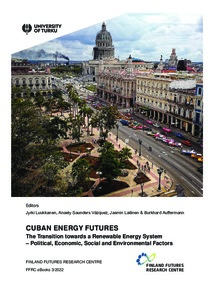Cross-Impact analysis of Cuban economic and energy development trends
Luukkanen Jyrki; Kaivo-oja Jari
https://urn.fi/URN:NBN:fi-fe2022081155043
Kuvaus
Tiivistelmä
The Cross-Impact analysis provides a tool for utilizing expert knowledge in the analysis of a complex system, where the interactions cannot easily be modelled with quantitative modelling techniques. Cross-impact analysis tries to take into account the various impact chains of the interactions 0,00 0,20 0,40 0,60 0,80 1,00 Investment US Embargo Share of Renewables Electric transport Oil production Climate change impacts Electricity demand GDP growth Industrialisation Energy use AXIOM Cross-impact growth probabilities Direct impact Direct and indirect impact 0.000 0.200 0.400 0.600 0.800 1.000 Investment US Embargo Share of Renewables Electric transport Oil production Climate change impacts Electricity demand Prosumer production GDP growth Oil import Industrialisation Energy use AXIOM Cross-impact growth probabilities Direct impact Indirect impact 121 of the selected variables. In this study, the indirect impact chains were evaluated. Indirect effects, which are not always taken into account in the analysis of the effectiveness of policy actions, can be assessed using CIA analysis. Our results show clearly how important it is to evaluate the indirect impacts. When assessing indirect effects, many critical variables received new interpretations for updated forward-looking long-run strategy analysis. Some critical variables changed to the domains of “driven buffer” (electric transport) and “reactive” (share of renewables and energy demand) variables. It is interesting to note that the variable “US Embargo” stayed in the category of the active strategic variable. The cross-impact analysis presented here for the Cuban societal energy system tries to illustrate the use of the method for analysing the system with complex interactions. In this CIA-analysis, we used three expert workshops to discuss the variables to be selected for the analysis and to construct the cross-impact matrix for the variables. The selection of the expert participants has a distinct impact on the selection of variables and the determination of their impacts. The use of experts with a large variety of background knowledge is advisable if the system under study has several features which cannot be covered with one field of expertise.
Kokoelmat
- Rinnakkaistallenteet [19207]
